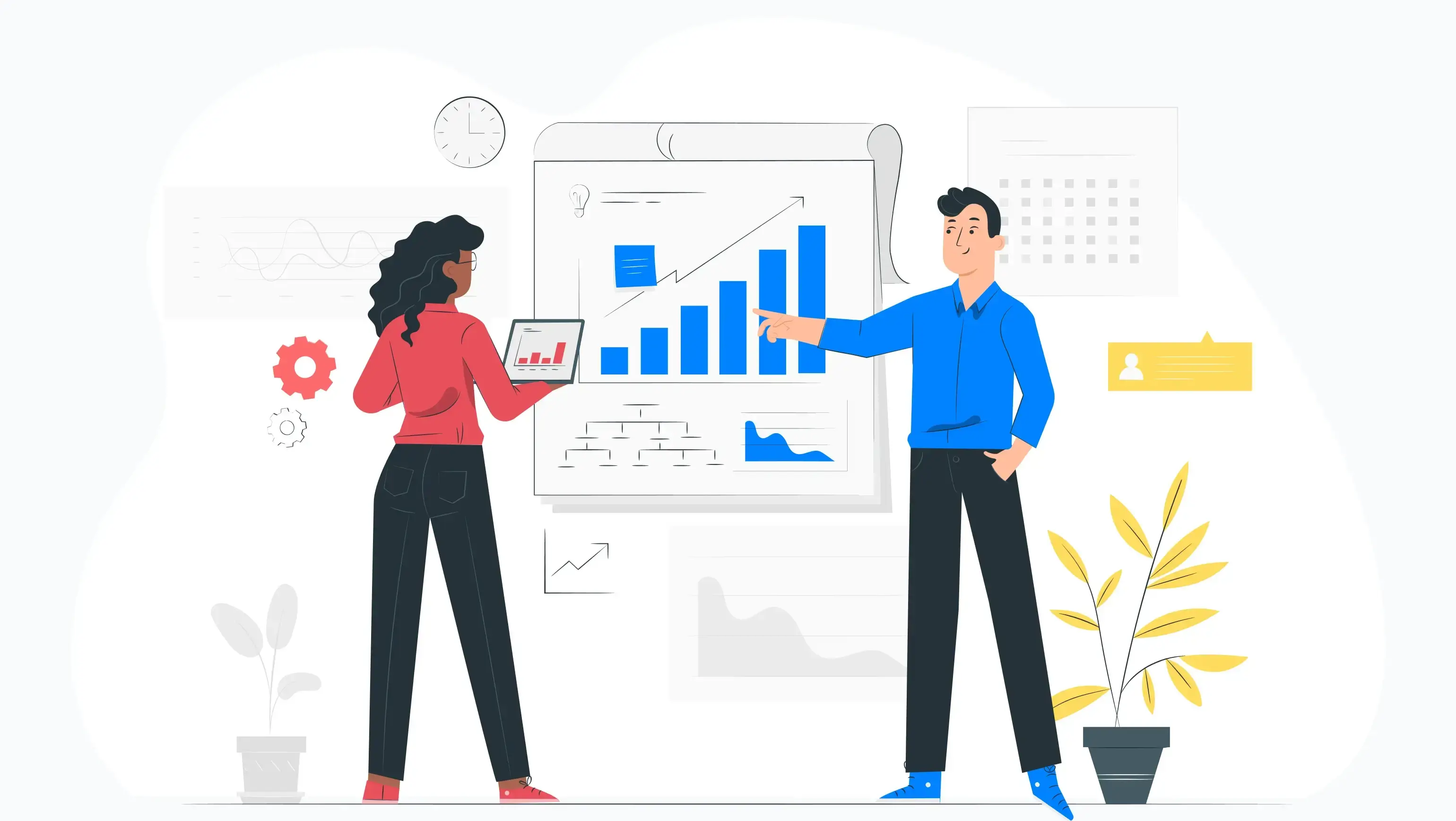

The days of static dashboards and passive data visualization in HR are over. In a world where agility and precision define business success, organizations need more than just snapshots of their workforce— they need actionable insights that drive meaningful change. People analytics is no longer just about understanding what happened; it’s about taking informed, timely actions to improve outcomes across your workforce.
The Shift: From Data to Action
Traditional dashboards were revolutionary in their time, offering a bird’s-eye view of key HR metrics. But today, they fall short. Why?
Huge cost incurred in data gathering and consolidation: As data becomes more intertwined in day-to-day decision-making, your data team has gone from digging up data insights to being buried in the backlog. The hidden cost of dashboards extends far beyond your data team. Whether you’re delivering a tailored employee experience, bringing a new performance philosophy for better talent management, or streamlining operations, data-driven decision-making is now an essential function of every role in your business.
Illusion of data-driven decisions: Consider the last dashboard you came across. Was it a clean, lean, optimized insights machine? Or was it a patchwork of disconnected, inconsistent technologies, with each downstream point dependent on the viability of the next? For the last three decades, dashboards haven't delivered on the promise of data-driven businesses
Delay in strategy and action: Creating new dashboards can require months of requirements gathering, data modeling, and development. By the time you’re getting your dashboard, the moment has passed. For instance, you’ve migrated off that SaaS tool and onto a new one, so the original data source is no longer applicable. Now, the business team is asking new data questions, and the data team is back at square one.
In contrast, action-oriented analytics reveal what’s happening and prescribe the steps to address challenges, enhance efficiency, and unlock potential. This shift is powered by advanced technologies like ML and AI, which transform raw data into strategies for success.
Why Action-Oriented Analytics Are a Must-Have
Organizations that embrace action-oriented analytics gain a significant competitive edge through faster, more informed decision-making. By moving beyond intuition and guesswork, HR leaders can rely on real-time, data-driven insights to ensure their strategies align with current trends and future outcomes. This approach enhances precision, enabling better resource allocation, swift responses to challenges, and smarter long-term planning.
Here’s how action-oriented analytics deliver impact across key HR functions:
Empowering Personalized Employee Experiences
Action-oriented analytics allow HR to design initiatives tailored to individual employee needs, boosting engagement, satisfaction, and retention. For example:
- Burnout Prevention: Monitoring indicators like overtime hours, task completion times, and sentiment data help flag potential burnout. HR can implement timely interventions such as wellness programs, workload adjustments, or flexible schedules.
- Custom Career Development: Predictive analytics can identify employees at risk of disengagement and suggest personalized development plans to keep them motivated.
Streamlining Recruitment Strategies
Traditional dashboards often present surface-level metrics, such as the number of unfilled roles or time-to-hire. In contrast, action-oriented analytics provide deeper insights, enabling HR leaders to:
- Optimize Hiring Strategies: Analyze past recruitment data to identify patterns, such as roles that consistently take longer to fill or regions with talent shortages, and address these proactively.
- Prioritize High-Potential Candidates: Beyond tracking applicant numbers, analytics can assess candidate behaviors and qualifications, predicting success and enabling hiring managers to focus on top talent.
Enhancing Performance Management
Action-oriented analytics transform performance management by recommending real-time coaching and identifying team dynamics that influence productivity. For example:
- Fostering High Potential: Analytics can spotlight employees with leadership potential and align them with strategic initiatives to encourage growth and innovation.
- Improving Team Synergy: By analyzing collaboration patterns, HR can address inefficiencies and enhance team dynamics.
Driving Proactive Workforce Planning
While traditional dashboards provide a retrospective view, action-oriented analytics enable forward-looking workforce strategies. For instance:
- Forecasting Skill Gaps: Predict future skill shortages based on market trends and recommend upskilling initiatives to future-proof the workforce.
- Integrating Workforce Planning: Analytics can align workforce planning with recruitment strategies by forecasting hiring needs based on business goals and turnover rates. For example, if a business is expanding into a new market, analytics can identify the required roles and suggest strategies to build a talent pipeline.
The Analytics of Today: Descriptive, Predictive, and Prescriptive
To fully unlock the power of people analytics, organizations must embrace a progressive journey through three levels of analytics maturity: descriptive, predictive, and prescriptive. By integrating these levels into every facet of HR strategy, organizations move beyond understanding the past to predicting the future and, most importantly, taking action to drive impactful outcomes. This approach enables HR teams to make smarter, data-driven decisions that are directly aligned with organizational goals.

1. Descriptive Analytics: Empower Decisions by Understanding the Past
Descriptive analytics represents the foundational level of analytics maturity. It focuses on analyzing and visualizing historical data to uncover trends and patterns, helping HR teams answer critical questions about the past and present state of the workforce.
This level of analytics helps HR teams answer questions like:
- What is our current attrition rate?
- How have engagement levels fluctuated over time?
A few key capabilities include:
- Data exploration and visualization tools for analyzing workforce trends, engagement levels, and productivity
- Advanced dashboards and custom reporting to track historical performance, key HR metrics, and workforce demographics
Predictive Analytics: Stay Ahead with Future-Focused Decisions
Predictive analytics represents the next level of maturity. It empowers HR teams to shift from hindsight to foresight, using historical data to forecast future outcomes and make proactive decisions. By leveraging advanced algorithms and machine learning, predictive analytics enables HR teams to anticipate challenges and opportunities before they arise.
Predictive analytics helps HR teams answer questions like:
- Who is likely to leave the organization, and why?
- Who is a better candidate for a job?
- Which candidates will thrive in our culture?
By shifting focus from reactive responses to predictive insights, HR teams can make informed decisions that reduce risks, improve employee satisfaction, and foster a thriving workforce. These advanced capabilities ensure that organizations make smarter hiring and development choices and create meaningful employee journeys that drive engagement and productivity.
Let us double-click on a few key examples to understand better.
- Matching and recommendations capabilities:
- Best Fit Candidate Identification: uses AI-based stack ranking and candidate recommendations to help recruitment teams identify candidates with the highest probability of success
- Buddy Recommendation: assists onboarding administrators in selecting ideal buddies for new hires to enhance integration and retention
- Internal Talent Marketplace: recommends career opportunities, identifies employees for new roles, and supports skill-based career pathing
- Learning Content Recommendations: addresses individual skill gaps by recommending relevant learning content, increasing learning relevance and completion rates
- Prediction Use Cases in HR that directly impact business:
- Candidate Joining Probability: Calculates a candidate's likelihood to join based on historical data patterns
- Attrition Predictor: Forecasts employee turnover using AI models that can be customized based on organization-specific data or deployed through a global model
- Absenteeism Predictor: This tool anticipates employee absenteeism by analyzing historical leave patterns and assisting managers with shift scheduling and resource planning
With predictive insights at their fingertips, HR leaders can move beyond data interpretation to implementing impactful strategies that mitigate risks, optimize resources, and foster a culture of resilience and growth.
3. Prescriptive Analytics: Best-suited Measures Suggested from data
Prescriptive analytics takes predictions a step further by forecasting outcomes and recommending specific actions to optimize results. It represents the highest level of analytics maturity, offering HR leaders clear, actionable steps to address challenges and capitalize on opportunities.
Prescriptive analytics helps HR teams answer questions like:
- What actions can we take to reduce attrition?
- How do we adapt to ensure productivity during peak leave periods?
Below are a few examples for a better understanding:
- Retention Strategies: Based on attrition predictions, the system can suggest targeted retention activities such as salary increments, skill development, or personalized engagement plans.
- Adaptive Scheduling: The system can use absenteeism forecasts to create flexible shift schedules that ensure continued business operations without employee burnout.
Other Advanced Technologies Powering Action-Oriented Analytics
To help organizations fully unlock the potential of people analytics, the market offers a range of advanced technologies embedded in analytics, providing granular insights and actionable recommendations. Some of these technologies, shaping the future of People Analytics, include:
- Regression Analysis
- Impact Analysis: Assesses the influence of various factors on employee engagement and productivity
- Attrition Prediction: Identifies key drivers of employee attrition by analyzing multiple factors
- Anomaly Detection
- Payroll Process Monitoring: Detects irregularities in payroll transactions to prevent errors and ensure accuracy
- Expense Risk Scoring: Flags high-risk expenses to identify potential fraud or policy violations
- Sentiment Analysis
- Utilizes advanced natural language processing (NLP) models to analyze textual feedback
- Predicts sentiment probabilities and categorizes text into positive, negative, or neutral sentiments, helping HR teams understand employee feelings and improve workplace practices
- Clustering and Classification
- Survey Data Analysis: Clusters survey responses to identify patterns in employee satisfaction and engagement
- Topic Modeling for Feedback Classification: Categorizes feedback into topics for targeted insights
- Word Cloud for Social Network Activity: Visualizes common themes in employee social network interactions
Darwinbox: Empowering with Personalized Insights for Confident Decision-making
Darwinbox's People Analytics empowers organizations to make confident workforce decisions. Over 700 organizations use Darwinbox to scale effectively, reduce attrition, improve onboarding, and optimize headcount—all powered by our actionable insights.
What sets us apart? Our ability to deliver tailored, role-specific insights that help every leader, manager, and HR professional make smarter decisions every day.
Ready to Take Action with Your Data?
In the fast-evolving world of HR, simply gathering data isn’t enough—you need to turn it into action. With Darwinbox’s contextual people analytics, you’re empowered to make data-driven decisions that drive change, enhance employee experiences, and deliver measurable business outcomes.
Contact us today to learn how Darwinbox can help you take immediate action with your data and transform your HR strategy.



Speak Your Mind